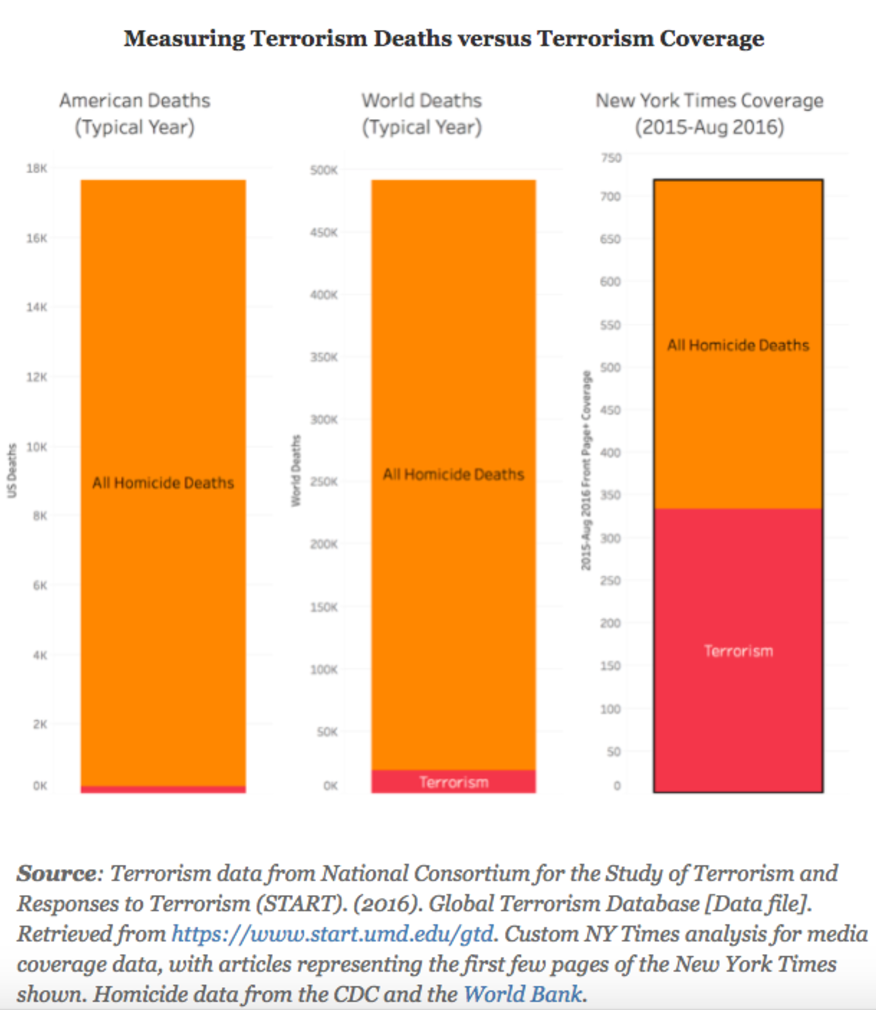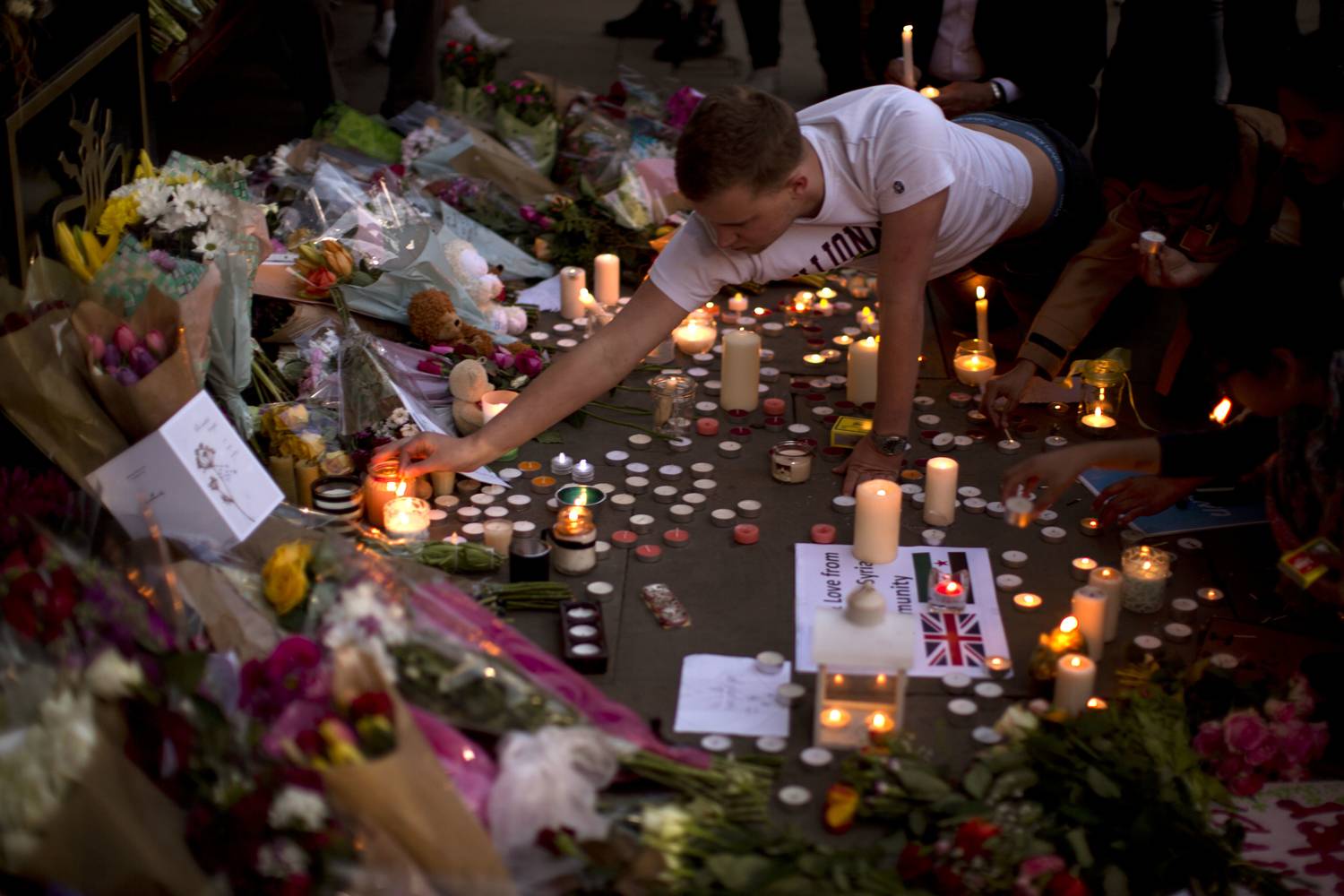Watching cable TV and listening to radio last night and this morning, I found myself trapped in an endless loop of panicked victims screaming and fleeing the suicide bombing at a concert in Manchester, England. Shaky witness cellphone video aired again and again, and the image of a girl leaping off a staircase lodged in my mind.
Yes, the attack is news. But does replaying footage of victims for hours or turning over the entire homepage to the story, as CNN, Fox News and Breitbart did, elevate the public understanding of why terrorism is committed or how to stop it? Or is it just lazy and sensationalist tabloid journalism, blowing the murder of 22 people out of proportion to stoke fear?

Screenshot, Breitbart.com
If the death toll were the issue, we would have heard more about the recent mudslides in Colombia that killed more than 200 people or the 1,683 Americans who die on average every day from heart disease, according to the Centers for Disease Control.
Just as troubling: Does flooding the public with images of terrified innocents further the malevolent agenda of those who seek to foment fear and hate in civilized society, by terrorizing those watching at home? A number of observers raised this point today, pleading with media to dial back the endless loop:
Dear cable news: Eyewitness video of people screaming and fleeing on endless loop doesn't further understanding, but does amp up fear.
— Josh Stearns (@jcstearns) May 23, 2017
Putting panic videos on loop on TV or sharing gory pics has no news value, just horrifies people *and* encourages copycats. Shameful.
— zeynep tufekci (@zeynep) May 23, 2017
Cable networks are doing the bidding of terrorists by repeatedly airing video footage of crowds running from the arena.
— Yashar Ali 🐘 یاشار (@yashar) May 23, 2017
At some point we'll get smart and stop identifying terrorists and giving them and their sick causes the attention they seek. STOP! https://t.co/U3XO3mw07L
— Joe Scarborough (@JoeNBC) May 23, 2017
Study after study — not to mention the diaries and social media accounts kept by perpetrators — reveal that terrorists and mass shooters thrive on the media attention and fame they’re guaranteed (even posthumously) by committing horrific crimes.
Michael Jetter, a behavioral economist at the University of Western Australia, analyzed 60,000 terrorist attacks between 1970 and 2012 that were reported in The New York Times. He found that terrorist groups have increasingly sought in recent years to exploit social and mass media, keeping their message alive on the “oxygen of publicity.” From videotaped beheadings by ISIS and al-Qaeda to Boko Haram’s kidnapping of young girls in Nigeria, the idea is to garner maximum media attention to draw impressionable recruits and instill fear in everyone else.
According to Jetter, one more Times story about a terror attack appeared to increase the number of subsequent attacks in that country by between 11 percent and 15 percent. On average, he concluded, an additional article was correlated with between one and two additional casualties within a week. Suicide missions get more media coverage, which may be why they’ve become more popular. His research raises troubling questions about whether devoting extensive media coverage to attacks ultimately results in more deaths down the line.
As Conor Friedersdorf pointed out in The Atlantic today, a 2015 analysis for Pricenomics by Nemil Dalal found “terrorism deaths are the single most heavily covered type of death per capita in the first pages of The New York Times compared to every other way a human can die,” fueling the impression that terrorism is a major source of death in the U.S. and Europe — which it isn’t.

Screenshot
Now this is certainly not to point a finger at the Times (it’s simply one of the most influential American news sources), nor am I saying the media shouldn’t cover terrorist attacks.
We have an obligation to report the facts and explain the news. But as with previous deadly attacks in Orlando, San Bernardino, Nice, Paris and Boston that dominated news for days or weeks, we should take into account the impact of our reporting. What we write and say and show affects both the fast-changing situation on the ground — those searching for loved ones or those who may be wrongly implicated in the initial investigation — and those watching around the globe who may feel nearly as traumatized as those who experience trauma first-hand.
President Trump sees the problem in reverse, claiming in February that the media downplayed or ignored terrorist attacks in an effort to undersell the threat from the Islamic State.
Challenged by reporters on which attacks they supposedly hushed up, the White House released a list of 78 over the previous two years, including Paris, Brussels and Orlando, which all dominated the news for weeks. Days earlier, Trump advisor Kellyanne Conway, who coined the term “alternative facts,” asserted on TV that Americans weren’t told of the “Bowling Green massacre” — an incident that in fact never happened.
Full disclosure: I’ve been part of the coverage of terrorism that has dominated our collective media consciousness since Sept. 11, 2001. I reported from Pakistan and Afghanistan on the next day and in the months after the 9/11 attacks, covered the Bali nightclub bombing that was the first high-profile attack on an entertainment venue, interviewed the American sailors who survived the attack on the USS Cole in Yemen.
From Washington, I covered the U.S. government response to hostage-takings and terror attacks in Iraq, Syria, Nigeria, Copenhagen, Boston, Paris and more. I focused on the victims, the investigations and the policy responses, and didn’t glorify the attackers, but by writing and talking about terrorists, I and my colleagues probably fanned fear as well.
Yet the further we get from 9/11, the more distance and experience we collectively gain, and there are a number of steps I think we can take improve our coverage in the public interest:
- Don’t adopt the lexicon or claims of terrorists. Is terrorism truly a “threat” to our democracy, or is it an isolated “risk” to lives? Yes, dedicating policy attention and resources to preventing and fighting terrorism is essential, but the truth is Americans are statistically more likely to die in an auto accident or by lightning strike than in a terrorist attack, so the risk shouldn’t be overblown.
- Don’t accept propagandists’ claims without multiple sources and evidence. Terrorism reporter Rukmini Callimachi of The New York Times urged caution today in a string of tweets explaining how different arms of ISIS may not be in sync:
1. Minutes ago, ISIS claimed responsibility for the deadly blast in Manchester. It appeared via Nashir, an official ISIS outlets pic.twitter.com/8QQDmTQ1Dz
— Rukmini Callimachi (@rcallimachi) May 23, 2017
- Reconsider referring to terrorists as “claiming responsibility.” Aren’t they “admitting guilt?”
- Deprive terrorists of what they want – the spotlight – and embrace the victims and their families, argues information technologist Zeynep Tufecki.
- Show the effects of terrorism without showing the gore. An example are photographs that show victims’ personal effects rather than body parts — shoes, stuffed animals, flowers placed to commemorate the victims.
UNESCO, the Paris-based educational arm of the United Nations, published a handbook this year for journalists covering terrorist attacks with its own useful guidelines, including these:
- Provide clear, precise, rapid and responsible information
- Take into account the impact of information on dignity and security
- Be wary of unsupported theories, peremptory judgments and pre-held biases
- Check the veracity of images before publishing
- Publish essential images without resorting to sensationalism
- Correct any errors immediately and visibly
- Keep a sense of proportion
- Don’t glamorize terrorists
- Avoid fostering fear
This all means covering news events as they happen, but also reporting carefully and accurately on suspects and victims, especially if children are involved, as they were at the Ariana Grande concert. Internet trolls and hoaxers rushed into the fray, posting appeals about supposedly missing children, which turned out to be fake, presumably causing pain to those in the photographs and to families of real victims.
Is there a better way to cover such incidents?
Stick to the facts, and when possible, emphasize what is working and what can be replicated elsewhere. Is there a successful anti-terrorism operation or investigation that other jurisdictions could learn from? Manchester police announced today zero tolerance for hate crimes and said it was essential the city’s “diverse communities stand together,” and the UK’s Sky News shared the video. The Independent newspaper shared images of solidarity with Manchester that went viral, a reminder that most people aren’t bad.
It was a useful counter to internet trolls and endless loops of shaky video that don’t illuminate the problem or tell us anything new.






